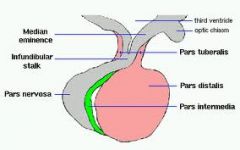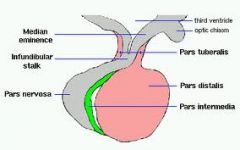![]()
![]()
![]()
Use LEFT and RIGHT arrow keys to navigate between flashcards;
Use UP and DOWN arrow keys to flip the card;
H to show hint;
A reads text to speech;
47 Cards in this Set
- Front
- Back
|
What are the three hormone chemical classes of the endocrine system?
Water or lipid soluble? Examples of each |
1. Proteins, polypeptides - water soluble (ex. insulin and follicle stimulating hormone)
2. Amino acid derivatives - water soluble (ex epinephrine) 3. Steroids - lipid soluble; from cholesterol (ex. testosterone and progesterone) |
|
|
Hormones elicit an action on the target organ by binding to a receptor that initiates ______ (the translation of signal to biochemical reaction)
|
signal transduction
|
|
|
Hypophysis, also called _____, is a pea sized gland that is on the base of the ______
This is important in regulating (3): |
-pituitary gland
-sella turcica Important in regulating: -growth -reproduction -metabolism |
|
|
What are the two divisions of the hypophysis?
|
-adenohypophysis (anterior pituitary)
tissue derived from roof of mouth, epithelial ectoderm -neurohypophysis (posterior pituitary) tissue derived from base of brain (diencephalon), nueral ectoderm |
|
|
Adenohypophysis develops from _______
|
-Rathke's Pouch (evagination of roof of mouth)
|
|
|
What are the three divisions of the adenohypophysis?
|

-Pars distalis (anterior lobe) - largest part
-Pars tuberalis - funnel-shaped region that surrounds neural stalk -Pars intermedia - thin remnant of posterior wall opposed to the infundibulum of neurohypophysis |
|
|
What are the three divisions of the neurohypophysis?
|

-Pars nervosa - Largest portion containing neurosecretory nerve endings
-Infundibulum - stalk-like portion containing axons of neurosecretory nerves -Median eminence - extends from inferior aspect of hypothalamus, maintains connection w/ brain |
|
|
What are the two categories of the pars distalis?
|
-Chromophils and Chromophobes
*Based on degree of staining |
|
|
The chromophils of the pars distalis can be divided into what two groups?
|
-Acidophils (stain with acid dyes)
-Basophils (stain with basic dyes) |
|
|
Acidophils in chromophils of the pars distalis can be further divided into these functional categories:
|
-somatotrophs - secrete growth hormone (somatomedin is a protein synthesized in liver that stimulates growth of long bones; stimulated by GH)
-Mammotrpohs (lactotrophs) - secrete prolactin (promotes mammary gland development during pregnancy and lactation after birth) |
|
|
Basophils in chromophils of the pars distalis can be further divided into these functional categories:
|
-Corticotrophs - secrete adrenocorticotropic hormone (ACTH) (stimulates adrenal cortex)
-Thyrotrophs - secrete TSH or thyrotropin (stimulates release of TH) -Gonadotrophs - secrete FSH and LH |
|
|
What do gonadotrophs do in females and males?
*Gonadotrophs are basophils in chromophils of the pars distalis |
-Females: monthly release of FSH and mid-montly LH surge triggers ovulation
-Males: FSH initiates spermatogenesis and LH stimulates steroid hormone production in Leydig cells |
|
|
What are chromophobes?
|
One of the categories of the pars distalis that is thought to be stem cells that can develop into chromophils
*don't stain |
|
|
What are the nonsecetory cells of the pars distalis?
|
-folliculostellate cells
|
|
|
What is the pars intermidia?
What does it secrete? |
-cleft between pars distalis and pars nervosa
-secretes melanocytes stimulating hormone (MSH) (unknown function) |
|
|
What is the pars tuberalis?
|
-(extension of anterior lobe) forms thin sleeve around infundibular stalk (of posterior lobe)
-Gonadotropins such as FSH and LH are secreted by most cells of the pars tuberalis |
|
|
This portion of the neurohypophysis extends from the floor of the hypothalamus:
|
median eminence
|
|
|
This portion of the neurohypophysis bridges the median eminence with the pars nervosa:
|
infundibular stalk
|
|
|
What are neurosecretory granules?
What are its contents? |
-Found in pars nervosa (posterior lobe) of neurohypophysis
(bulk of pars nervosa = unmylinated secretory axons) Contents: -oxytocin - hormone that stimulates contraction of smooth muscle in uterus and mammary gland myoepithelial cells (milk ejection) -Antidiuretic hormone (vasopressin) - increase water resorbtion in renal collecting ducts and induces arterial smooth muscle contraction (increases BP) -Neurophysins - binding proteins specific for each hormone |
|
|
Herring bodies are accumlations of _____
|
neurosecretory granules
|
|
|
What are pituicytes?
|
Glial cells that are associaged with secretory axons. The nuclei are commonly found in the pars nervosa
|
|
|
What two arteries supply the hypophysis?
What does each supply? |

-Superior and inferior hypophyseal arteries (branch of internal carotid artery)
-Superior - supply median eminence & neural stalk -Inferior - primary supply the posterior lobe |
|
|
What forms the primary capillary plexus?
What drains the primary capillary plexus? |
-formed from superior hypophyseal arteries (network of fenestrated capillaries in median eminence)
-hypophyseal portal veins drain the primary capillary plexus |
|
|
Give the blood flow of the superior hypophyseal arteries:
|
primary capillary plexus --> hypophyseal portal veins --> secondary capillary plexus
|
|
|
Both secondary plexus and the posterior lobe exit the hypophysis into the ______
|
-cavernous sinuses
|
|
|
What is the critical function of the blood flow of the hypophysis?
|
-Neurosecretory hormones are synthesized by hypothalmic neurons and are stored in median eminence (supplied by superior hypophyseal artery)
-Hormones can then be released at the primary capillary plexus and carried into the secondary plexus where they stimulate/inhibit effect on cells of the pars distalis |
|
|
The thyroid can be found immediately inferior to the ____
|
larynx
|
|
|
What joins the right and left lobe of the thyroid?
|
isthmus
|
|
|
What portion of the thyroid are thyroid secretory products stored?
What is the storage form of thyroid secretions? What makes this different from other endocrine glands? |
-follicles
-colloid -endocrine glands are stored extracellularly *colloid is the inside of the spherical follicles |
|
|
What are the two cell types of the thyroid?
|
-Follicular cells (principal cells)
-Parafollicular cells (C cells) |
|
|
What do the follicular cells of the thyroid secrete?
What are their functions? |
-Thyroxine (T4)
-Triiodothyronine (T3) -regulation of cell and tissue metabolism -induce increased protein synthesis and carbohydrate metabolism -important in body growth and nervous system development (hormone binds nuclear receptors and stimulate RNA transcription) |
|
|
Which of the follicular cells of thryoid is more abundant? Which is more potent? Which is converted to the other by variious organs?
|
-Thyroxine (T4) is secreted 10 times more, but is much less potent
-Thyroxine (T4) is converted to triiodothyronine (T3) by various organs |
|
|
What is thyroglobulin?
|
inactive storage form of thyroid hormones (primary constituent of colloid)
|
|
|
Iodide is pumped from ____ to ____ by iodine pumps
|
blood to follicular cells
|
|
|
What does thyroid peroxidase to?
|
oxidizes iodide to iodine (iodine is released at apical surface into follicle lumen)
|
|
|
That happens to tyrosine residues that are present in thyroglobin?q
|
-it is iodinated in the follicular lumen
|
|
|
What are the steps of the release of thyroid hormones into the bloodstream?
|
-Follicular cells take up colloid droplets (via receptor mediated endocytosis)
-colloid resorption droplets fuse with lysosomes and preteases cleave iodinated residues from thyroglobulin -monoiodotyrosine and diiodotryrosine becomes deiodenated (via thyroid deiodinase) -liberation of T3 and T4 |
|
|
What are the characteristics of the parafollicular cells (C cells)?
From where do they arise? What do they secrete? |
-type of thyroid cell located between follicles and do not contace follicular lumen
-arise from neural crest -secrete calcitonin - control blood calcium levels (concentration rises with rise in serum calcium levels - cause osteoclasts to revert to inactive state) |
|
|
Where are the parathyroid glands located?
|
-four small glands which are located behind the thyroid
|
|
|
How are vessels, lymphatics and nerves carried into the parathyroid gland?
|
-connective tissue projects into the gland creating CT septa, that carries these into the gland
|
|
|
What are the two cell types of the parathyroid gland?
|
-Chief Cells (Principal cells)
-Oxyphil Cells |
|
|
What do the chief cells of the parathyroid gland secrete?
What is the function of this? |
-secretes PTH caused by the decrease in circulating calcium
-OsteoClast stimulating factor secretion is induced when PTH binds to receptors on osteoBlasts -reduces calcium elimination (urine) and increases vitamin D production through kidney *Chief cells are the most numerous cell types |
|
|
What are the function of the oxyphil cells of the parathyroid gland?
|
-unknown function (may represent inactive or necrotic chief cells)
|
|
|
What two hormones regulate calcium levels?
|
-Calcitonin (from thyroid - parafollicular cells)
-PTH (from parathyroid - chief cells/principal cells) *calcitonin has more rapid effect than PTH |
|
|
What changes occur in the parathyroid glands with age?
|
secretory cells are replaced by adipose cells with increased age
*50-60% of the gland is adipose in older individuals |
|
|
Hormones that bind to cell surface receptors initiate signal transduction via different mechanisms, ALL of which involve what?
|
protein kinase
|
|
|
Endocrine glands differ from exocrine in that they (do/do not) have ducts.
|
do NOT have ducts
-instead secretes hormones using blood stream or tissue fluids |

